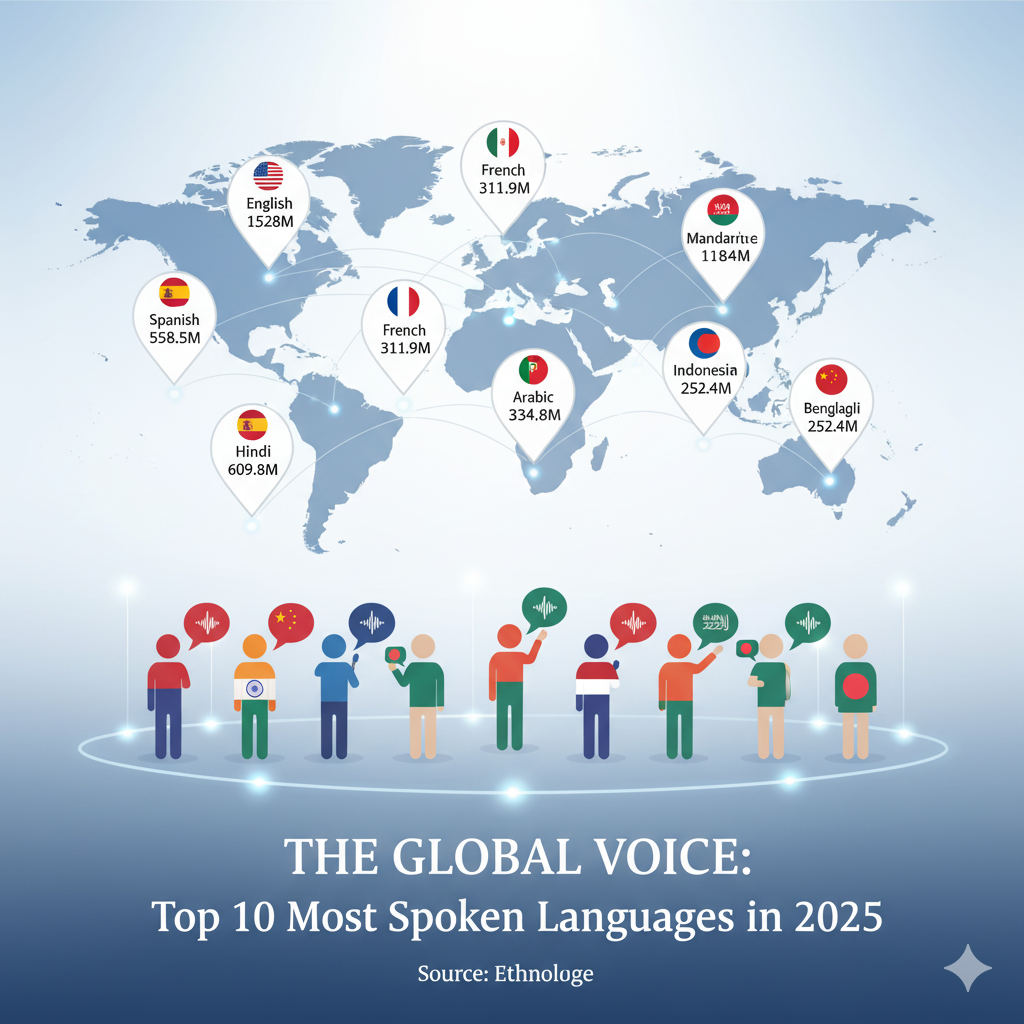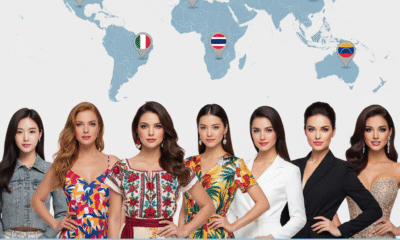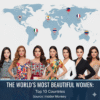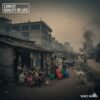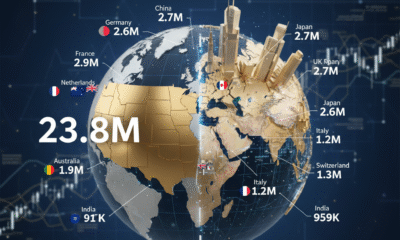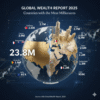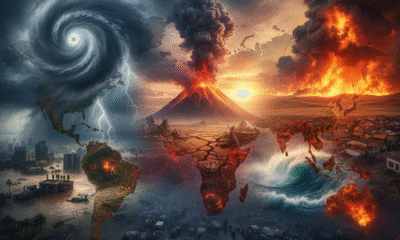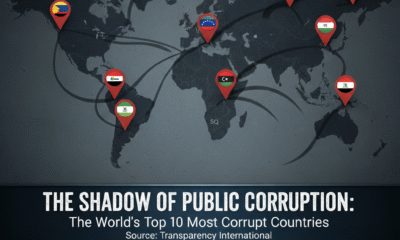World News
Top 10 Most Spoken Languages in 2025
Language connects people across places and shapes cultures and history. As the world becomes more global, some languages have grown far beyond their original homes. They are now spoken by millions across different countries and continents.
According to Ethnologue (2025), ten languages dominate global communication. These languages have shaped trade, education, culture, and international relations. Their influence comes not only from the number of people who speak them but also from their roles in history and daily life.
This article looks at the ten most spoken languages in 2025.
1. English (1528 Million Speakers)
English is the world’s most spoken language. It reaches over 1.5 billion people. This includes both native speakers and those who speak it as a second language. English is key in business, science, and the internet.
English is a West Germanic language. It originated from the languages brought to Britain by Germanic tribes, the Angles, Saxons, and Jutes, starting in the 5th century AD. This early form is called Old English. It replaced the native Celtic languages.
The language changed greatly after the Norman Conquest in 1066. The French language of the new ruling class mixed with Old English to create Middle English.
Later, Early Modern English, used by figures like William Shakespeare, developed. Global expansion by the British Empire spread English across continents. This established it as a major international language.
2. Mandarin Chinese (1184 Million Speakers)
Mandarin Chinese holds the second spot with over a billion speakers. Most of its speakers live in China. It is the official language of the People’s Republic of China.
Mandarin is part of the Sino-Tibetan language family. Its roots go back over three thousand years to Old Chinese. Old Chinese was the language of the early dynasties. The variety that grew into Mandarin developed in Northern China.
The Beijing dialect became the basis for Standard Chinese, or Putonghua (Common Speech). This standardization happened over centuries. It became the language of the court during the later imperial dynasties. The government chose it as the national language in the 20th century to unify the country’s many dialects.
3. Hindi (609.1 Million Speakers)
Hindi is the third most spoken language. Most of its speakers live in India. Hindi is one of the official languages of the Indian government. It acts as a major link language across North and Central India.
Hindi is a direct descendant of Sanskrit, the ancient language of India. It belongs to the Indo-Aryan branch of the Indo-European family. An earlier form, called Old Hindi, was spoken around Delhi in the 8th to 10th centuries.
The language grew a lot during the time of Islamic rule in Northern India. It took in many words from Persian and Arabic. Modern Standard Hindi emerged in the late 18th century. After India’s independence in 1947, the government standardized the grammar and orthography using the Devanagari script.
4. Spanish (558.5 Million Speakers)
Spanish is the fourth largest language in the world. It is a dominant language in 20 countries, mostly in the Americas. Its global spread shows the legacy of the Spanish Empire. Spanish is a vital language for Western culture and international relations.
Spanish is a Romance language. It came from Vulgar Latin, the common form of Latin spoken by the Romans. The Romans brought it to the Iberian Peninsula starting in the 3rd century BC. After the Roman Empire fell, this Latin evolved into different dialects.
The specific dialect that became Spanish developed in the Kingdom of Castile. It is sometimes called Castilian. During the Reconquista, this dialect spread south across Spain. Spanish explorers and colonizers carried the language to the Americas starting in the 15th century.
5. Standard Arabic (334.8 Million Speakers)
Standard Arabic ranks fifth in global speakers. It serves as the formal language across the Arab world. It is the language of media, literature, and government from the Middle East to North Africa. It is also the language of the Quran, the holy book of Islam.
Arabic belongs to the Semitic branch of the Afroasiatic language family. Its earliest forms date back to the Arabian Peninsula. The Arabic of the Quran is known as Classical Arabic. It became the standard for writing.
The spread of the Islamic empire starting in the 7th century C.E. caused Arabic to spread widely. It became a language of science and scholarship. Modern Standard Arabic (MSA) developed from Classical Arabic. It is the version used today in formal settings, though local dialects vary greatly in daily speech.
6. French (311.9 Million Speakers)
French is the sixth most spoken language. It is a truly global language. It is an official language in 29 countries, often due to France’s colonial history. It is a major language of diplomacy, culture, and international organizations.
French is a Romance language. Like Spanish, it evolved from Vulgar Latin in the region of Gaul, now France. The language was influenced by the native Celtic language, Gaulish, and by the Germanic language of the Franks, the tribe that gave France its name.
The language developed through the periods of Old French and Middle French. In the 17th century, the Académie Française was founded. Its goal was to protect and standardize the language. This effort helped French become the refined language of European courts and global diplomacy.
7. Bengali (284.3 Million Speakers)
Bengali is the seventh largest language by speakers. Most of its speakers live in Bangladesh and the Indian state of West Bengal. It is known for its rich literary tradition and cultural importance.
Bengali is an Eastern Indo-Aryan language. It developed from the Middle Indo-Aryan languages spoken in the ancient Magadha Empire. Its ancient roots are in the Prakrit languages. This language family is influential in South Asia.
The language evolved through Old Bengali and Middle Bengali. Islamic rule in Bengal caused the language to adopt many words from Persian and Arabic. The Bengali Renaissance in the 19th and early 20th centuries led to the development of Modern Bengali. A movement to establish Bengali as an official language was a major part of the creation of Bangladesh in 1971.
8. Portuguese (266.6 Million Speakers)
Portuguese is the eighth most spoken language worldwide. It is the official language of Portugal, Brazil, and several African nations. Brazil’s large population makes up the majority of Portuguese speakers.
Portuguese is another Romance language. Its origin is in the Vulgar Latin that the Romans brought to the western Iberian Peninsula. After the fall of the Roman Empire, this Latin developed into Galician-Portuguese.
In the 12th century, the County of Portugal separated politically from Galicia. This separation helped the language become distinct. The Age of Discoveries, starting in the 15th century, spread Portuguese around the world. It reached South America, Africa, and Asia, becoming a truly global language.
9. Russian (253.4 Million Speakers)
Russian is the ninth most spoken language. It is the official language of Russia and a key language in many former Soviet Union countries. It is the most geographically widespread language of Eurasia. It is also one of the six official languages of the United Nations.
Russian belongs to the East Slavic branch of the Slavic languages. Its ancestor is Old East Slavic. The language was heavily influenced by Old Church Slavonic. This older language was used for religious texts.
Political reforms by Tsar Peter the Great in the 18th century brought in many words from Western European languages. The writings of poet Aleksandr Pushkin in the 19th century helped establish the modern literary standard. The language continues to serve as an important language for technology and science.
10. Indonesian (252.4 Million Speakers)
Indonesian, or Bahasa Indonesia, rounds out the top ten. It is the official language of Indonesia, the world’s largest archipelago nation. Its selection as the national language was a deliberate act of unification.
Indonesian is a standardized register of the Malay language. Its deep roots are in Old Malay, which spread as a trade language in Southeast Asia from the 7th century. Malay has always been an accessible and flexible language for trade.
When Indonesia declared independence in 1945, the government chose Indonesian as the official language. They chose it because it was already widely used across the islands for commerce and travel. This choice helped unify the diverse nation, despite the presence of larger local languages like Javanese.

